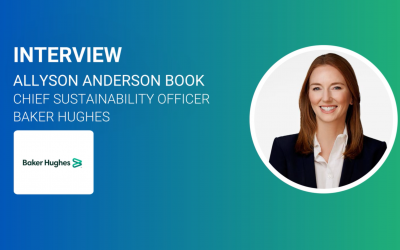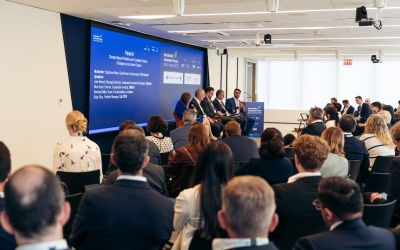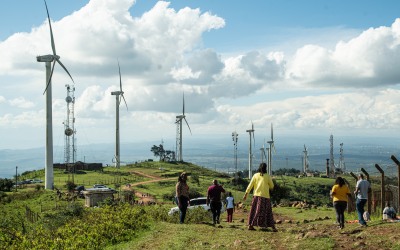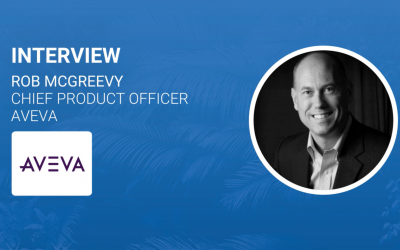Lindsey Hall on how S&P Global will support corporate transparency on carbon emissions
After the Sustainable Innovation Forum 2021, Climate Action caught up with Lindsey Hall, Head of ESG Thought Leadership at S&P Global Sustainable1, to discuss how S&P Global will support corporate transparency on carbon emissions.

After the Sustainable Innovation Forum 2021, Climate Action caught up with Lindsey Hall, Head of ESG Thought Leadership at S&P Global Sustainable1, to discuss how S&P Global will support corporate transparency on carbon emissions.
What do you think are the main challenges to reach net-zero and carbon neutrality? And how is S&P hoping to overcome these?
Over the past year, we’ve seen a huge increase in the number of companies setting goals to reach net zero emissions by 2050. But with stakes this high, just setting the long-term climate commitments is not sufficient. The challenge is ensuring that companies are also providing credible, near-term signposts on their path to decarbonization. And leadership teams must be accountable for those near-term goals. So part of the challenge is getting the right data, and getting it in a uniform way that is useful to investors, to companies, to policymakers. We need that data in order to make smart, immediate decisions in the near term that will prepare us for the longer-term goals everyone is now setting. Because as the August 2021 IPCC report told us in no uncertain terms: We need to act with urgency to lower emissions and adapt to the impacts of climate change at a more rapid pace and at greater scale.
What do you think the corporate transition strategy will look like in the lead up to 2050 and the supposed net-zero future?
The word we keep hearing in the sustainability world is “urgency”: We need to act with urgency because at the moment we’re not on track to meet Paris Agreement goals. New research by S&P Global Sustainable1 shows that almost every sector in the S&P 500, S&P EUROPE 350 and S&P Asia Pacific LargeMidCap is over budget on Scope 1 and Scope 2 emissions relative to Paris Agreement goals, S&P Global Trucost data shows. Our findings reinforce the need for companies to set credible near-term signposts on the path to their ambitious long-term climate targets. The analysis also suggests that there is significant room for improvement when it comes to creating the climate accountability that more and more investors and regulators are demanding.
One way to ensure accountability is to tie remuneration to climate goals — and that’s an approach that we’re seeing regulators and investors across the globe weighing. There appears to be growing investor support for linking remuneration to environmental, social and governance goals, but U.S. companies lag global peers in tying executive compensation to climate, the 2020 S&P Global Corporate Sustainability Assessment shows.
How will S&P ensure corporates are held accountable for their carbon emissions?
S&P Global brings together the data to help understand the fast-evolving sustainability world. Our data helps companies and investors quantify greenhouse gas emissions across the global value chain — from company operations to supply chains to bank loan books. Our data also helps clients understand high-impact business activities with S&P Global analytics on coal exposure, fossil fuel reserves, utilities and mining.
We have tools that help investors and asset managers track the alignment of investment portfolios and companies against the Paris Agreement goals of limiting global warming to 1.5 degrees and 2 degrees Celsius, with forward looking analytical tools spanning 14,000 companies representing 99% of global market capitalization.
We also help people understand what’s next. For example, S&P Global’s Trucost physical risk data shows the exposure of assets all around the world to different physical risks of climate change like wildfires, flooding and heatwaves under different climate change scenarios.
Trucost Paris Alignment Data shows how companies and sectors align with Paris Agreement energy transition pathways. Trucost Carbon Earnings at Risk Data lets clients stress test a company’s current ability to absorb future carbon prices and understand potential earnings at risk from carbon pricing on a portfolio level. That’s naming just a few of the solutions.
Do you think 2050 goals and targets are a productive means of obtaining net-zero? How can companies capitalise on interim targets, and what should they aim to have achieved by 2025?
Goals for 2050 are useful only when accompanied by credible near-term signposts along the route to eventual net zero. Even though most national net zero targets are decades away, the world would need to make significant strides in decarbonizing energy-related emissions within the next four years to achieve net zero emissions by 2050.
Recent research by S&P Global Sustainable1 found that even under a less ambitious scenario in which global warming is limited to 2 degrees C, the world would need to make cuts to fossil-fuel related emissions across multiple sectors by 2025. For example, we found that almost all energy end-use sectors, ranging from heavy industry to transport, would need to cut annual emissions by 2025 relative to 2019 levels under our 2-Degree Outlook; 2025 CO2 emissions under the 2-Degree Outlook would be 9% below emissions under the Reference Case Outlook.
The research is based on an analysis of two S&P Global Platts Analytics Future Energy Outlooks: One, the Reference Case, reflects the current state of policies, technologies and markets, as well as expectations on how those factors are most likely to evolve. The second is the more ambitious 2-Degree Outlook, and in the research, we examine how carbon dioxide emissions would need to change across geographies, sectors, and the power supply mix to limit global warming to 2 degrees.
How did you incorporate sustainability into your own career path, and why does this topic hold meaning for you personally?
My role is all about taking the data and explaining it. My personality is that whenever I’m faced with a problem, I like to make a plan to address it — and in order to make a plan, I need to understand the situation. Climate change is the biggest and thorniest problem we face, and so it requires a lot of information. My role as Head of Thought Leadership means I am talking all the time to smart people — our data specialist in house, as well as climate scientists, analysts, executives, investors, policymakers, academics — trying to understand the data and then using it to explain what is happening and what needs to happen next. I co-host a podcast for S&P Global called ESG Insider where we do a lot of this kind of explanation—trying to take this big, thorny problem and break it down into something manageable so we can take action.
S&P Global Sustainable1 are speaking at the Sustainable Innovation Forum 2021, to join them register here now.






